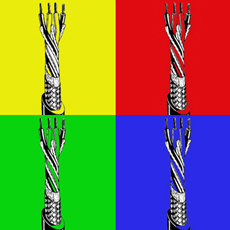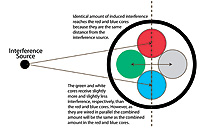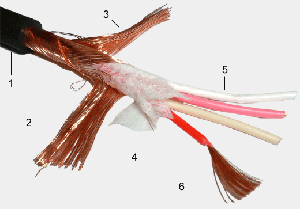Star-quad design is sometimes quite a bit of talked about cable type. When I saw Star-Quad Cables and Double-Blind Testing posting at Controlgeek blog I decided that it would be a good idea to write something about them.
Several companies use a quad configuration in their balanced cables instead of a twisted pair; Canare calls this Star Quad. The design uses four conductors twisted around each other; opposing pairs are connected at either end.
The star-quad design for microphone cables, where 4 conductors are used in pairs, with a short lay length, to cancel out the effects of external electromagnetic noise, is well known in demanding applications such as TV, video and theatre where thyristor lighting control systems are in use. Star quad, four conductors in square formation, in which opposite conductors are connected in parallel at both ends to form a single, magnetically-concentric balanced pair, in order to minimize magnetic induction. The truth is that it works. I have tested star-quad cable arrangement against normal twisted pair cable, and I have to admit that it rejects the noise better when I have tested that on lab environment (comparing several cable constructions).
A star-quad cable resembles kind of super-set of a normal twisted pair microphone cable. There are four cores in star-quad cable plus an overall screen. The screen helps to prevent electrostatic interference from reaching the signal cores, just as in a conventional cable. What’s special about star-quad cable? article tells that the four cores are very tightly twisted with each other and rotate over a relatively short length. The very short lay length of the core twisting also helps to make sure that any interference is induced equally into the the two paired sets of wires (although works quite well even if the twists are not very tight like in Gotham “Star-Quad”). This arrangement results in a magnetically coaxial structure and provides greatly improved rejection of electromagnetic interference compared to standard two-core mic cables.
The result of start-quad construction is better balance of interference and therefore better rejection. What’s special about star-quad cable? article mentions that the improvement is perhaps as much as 20dB. Up Your Audio: Time For Star Quad Microphone Cable article tells that star-quad cable is raising common mode rejection (CMRR) by a factor of 10, or about 20 dB.
The rejection is better especially for very close-source electromagnetically induced interference. You get this kind of interference when you lay a mic cable alongside something that radiates strong and nasty interference (mains power cables, dimmer cables). Star-quad cables are widely used today, particularly where there is a likelihood of having to lay mic cables alongside strong sources of interference.
Quad cable provides increased immunity to radio interference as well. The “Star-Quad” concept is known and recommended where the RF-rejection is the most important factor and where very long cable runs are needed. The star-quad configuration was invented for use in telephone cables back in the ’30s, and was adopted in the TV world in the ’60s and ’70s.
So how does the star-quad cable differ from normal microphone cable in technical properties? According to Up Your Audio: Time For Star Quad Microphone Cable article a star-quad mic cable contains four 24-gauge wires instead of the usual single 22-gauge pair. The four wires spiral together tightly so they alternate plus and minus, creating better “looping” that improves resistance to electromagnetic interference.
The four cores are arranged in a cross formation, and the opposite cores are wired in parallel to form a single balanced pair. The very short lay length of the core twisting also helps to make sure that any interference is induced equally into the the two paired sets of wires. Star-quad cable works very well with balanced audio signals.
Star quad construction reduces the inductive reactance of mic cable: Replacing a 22-gauge twisted pair with two pairs of 24-gauge conductors connected in parallel produces the same DC resistance, but about half the series inductance.
The downside is higher capacitance: with four wires in the cable, the core-core and core-screen capacitance will be higher than in a more conventional two-core cable.
If this provides better clarity without the need for EQ to boost the highs or causes loss of high frequencies due capacitance could depend on which kind of devices are connected to the cable. I think the effect could be in either case by case.
Up Your Audio: Time For Star Quad Microphone Cable article recommends to consider a new set of star quad microphone cables as the most affordable way to improve sound. According to that article nothing that costs so little can make such a big difference in the quality of a sound system as its mic cables and using phantom powered mics places a higher demand on mic cables than simple passive devices. According to Up Your Audio: Time For Star Quad Microphone Cable article claims that star quad cables can also improve sound quality. Most report clearer highs, less mud in the mid-lows, and a lift of the “haze” associated with previous mixes. I can’t verify those claims. I have not used that so much in real life audio systems that I could say does it sound better like one article claims. If you have noise problems then considering star-quad cable could be a reasonable idea. I don’t think that they could really make things sound better, but they sure can reduce interference.




63 Comments
Gregg Akahi says:
I just want to mention I’m all new to blogs and honestly liked you’re blog. Very likely I’m want to bookmark your blog . You really have beneficial writings. Thanks a bunch for sharing your web-site.
Oscar Accountants says:
I’m hunting to get out as much in regards to the on the internet browsing community as I am able to. Can any person advise their favorite blogs, twitter users, or websites that you just find most thorough? Which of them are most popular? Thanks!.
Marco Labriola says:
A motivating discussion is definitely worth comment. I do think that you should write more on this subject matter, it might not be a taboo matter but generally folks don’t speak about these issues. To the next! All the best!!
t shirts says:
nice to find out Star-Quad Cables
Augustine Mattick says:
Excellent weblog right here! Additionally your web site a lot up very fast! What host are you the use of? Can I am getting your affiliate link on your host? I wish my website loaded up as quickly as yours lol
Sina Autrey says:
Hey there! I just noticed your site: Star-Quad Cables Tomi Engdahl& when I was browsing stumbleupon.com. It appears as though somebody enjoyed your site so much they made the decision to bookmark it. I’ll certainly be coming here more regularly.
Vinodini Menon says:
Quotation Required :
Dear Sir/Madam,
We hereby request Best prices, Availability, Delivery Time & Terms for the following materials :
Sr. No. Item Description Qty. Rate
1 Inspection and supply of :
NTC Resistance Based Temperature Sensors for 2K application along with calibration certificate
(Detailed Specification Attached) 56 Nos.
2 Quad Twist Pair wire for Cryogenic Instrumentation Wiring
(Detailed Specification Attached) 1000 Foot
NOTE:-Please send the Datasheet/Catalogue/Specification also mention the Make & Model of your offered product. Same is required with offer for further evaluation
Kindly send your offer as per specifications – and if there is any deviation highlight the same in your Quotation.
An earliest response would be appreciated.
Thanks & regards
Vinodini Menon
(Office Working Time : 10.30 am to 5.30 pm)
06/00002
16/2, Govardhan Bhuvan CHS Ltd.,
212/218, Khetwadi main Road,
Mumbai – 400004
Tel : +91-22-66362470/8169194277
Email : [email protected]
tomi says:
I have found that http://akismet.com/ is a solution that works.